#this is maslow’s heirarchy of needs. Bottom level
Explore tagged Tumblr posts
Text
Building Well-Rounded Characters: Maslow's Heirarchy
This is the first in a series of posts on Character Development, focusing on the psychology of the characters and the importance of backstory. Read the caption for more information on this series.
A question writers often ask about their characters is: What do they need, and how can I prevent them from getting it? Answering this question creates your characters goals, motives, and the conflict of your story, which really is the backbone of your novel. Well, it turns out a person's needs is much more intricate and fluctuates regularly. Maslow's Hierarchy of Needs depicts 4 levels of needs that need to be met before we can be 'fulfilled' or, self-actualized.
What is Maslow's Hierarchy?
Maslow's Hierarchy is a psychological theory that you've probably heard of if you've taken a Health or Psychology class. It's a pyramid that shows human needs from basic to most intricate, with 4 levels between the bottom and 'self-actualization. Understanding what these needs are will create the foundation for your characters motivations. The path to the top of the pyramid is not a perfect, linear one, and we might bounce around from level to level, half on one step and half on another. That being said, your characters might be motivated by more than one thing, and often their place on the hierarchy is not clear.
Basic Needs: Physiological Needs and Safety
Physiological needs include food, water, shelter, etc. They're the things that you need to sustain life. Withholding these from your characters creates life or death circumstances, and their focus must be on survival. Threatening these needs engages readers because the stakes are literally life or death.
Safety needs include security, order, and stability. There may not be a survival risk, but there is a certain risk that scares your characters. People like to know what to expect, and we feel unsafe when we're uncertain. When we're constantly messing up a character's life, the risks might not be life or death, although the character certainly feels that way. What does your character need to survive, and what do they need to feel safe?
Love and Belonging
These needs involve a social connection to people around us. We need people in our life who love us, whether its friends, family, or a significant other. These are the more intricate, emotional/psychological needs. Books that are built on aa character's search for someone who lives then and a home to belong to are usually very character driven books whereas threatening your character's survival tends to focus on plot. Understanding where your character is on this level means knowing who their 'people' are, what your characters roles are, and which people really love them compared to others who could care less.
Esteem Needs
There are two sub-sections to this level; the first being esteem for self including dignity, achievement, and independence, and the second is and more outward, focusing on needing other people to recognize that you're a decent, well-off human, things like reputation and respect. Writers need to know what makes their characters feel accomplished, and what they like about themselves. How important is their reputation, and how does the character's perception of themselves differ from what others actually think of them?
Self Actualization
The final level of the Hierarchy is the most difficult to handle, in which you must realize your potential, feeling self-fulfilling, and becoming everything you are capable of becoming. Most characters might be pretty far off the mark on this one, and that's fine. But, by the end of your novel, there should be some sense of fulfillment. This is another kind of character-driven story, and it's all about figuring out who you want to be. Easy, right?
1 note
·
View note
Text
Me: I hate getting attention, why would I ever /need/ that, I don’t really, it’s just fun every once in a while, I’ve never /needed it/ before, I definitely don’t now!!!
My partners: *gives me attention frequently now*!
Also me @ them now: I want you both here /right now/!!!!!!! With me!!!! And I /will/ pout about it and be grumpy!!! I am in desperate need of all the kinds of attention!!!! Every single one!!! Gib!!!! I demand!!! (Only if you wanna though) BUT I DEMAND— I WILL DIE WITHOUT IT— IT’S A STRONG NEED AT THIS POINT— IT’S ON THE BOTTOM LEVEL OF MASLOW’S HEIRARCHY OF NEEDS—
3 notes
·
View notes
Text
Dear Maslow,
I currently thrive on the bottom levels of your pyramid. I can't seem to move up but you'd be pleased to know that there are still people out there who have quite mastered the drill. You'd be amazed by how they move around with ease.
Life here isn't great, as you already know. There are good days sure, but the bad days...they're really bad. I've been trying to build a socioeconomic ladder for some time now. Wouldn't want you to think that I'm just idling, waiting for some fortuitous events to happen. I said fortuitous, like what happened with you and Bertha *winkwink*.
In all seriousness though, whenever I get to that last rung the ground always breaks and the next thing I know everything around me is quicksand. What am I doing wrong? Do I need to use a different ladder? Or is there actually a stair somewhere? How do I navigate this treacherous heirarchy?
Since you can't possibly answer my dumb questions I guess I'll just have to come up with my own. And by that I mean, I have not a single idea honestly. All I have are questions. I know for a fact that I should still keep trying--and try I must. So there's that at least. Gotta stay D-motivated and maybe someday, somehow, I'll finally be able to move past some levels and be on top. That'd be all for now, Maslow.
Kind regards,
-K.
1 note
·
View note
Text
Effective Copywriting Reflection
This month was very insightful for me. For someone who works in motion graphics and video, the copy has always been an afterthought. I have always known that copy is important, but since someone else always does it, I never really thought about how copy is the voice of the brand.
Reading George Felton's book Advertising: Concept & Copy has been very insightful. Felton says “Until you discover the real reasons that people buy this or that good or service, or identify with this brand instead of that brand, you create ads for no one”(p.8). It has helped me see the whole picture of a product's brand messaging and its voice and how to write copy the reflects that voice.
I really enjoyed the section about customer needs, and how Felton talks about Maslows hierarchy of needs. He talks about how to reach a consumer higher level of needs, you must satisfy the consumer's lower levels of needs first (Felton, p22). This really made me think more about products and how the product meets consumer needs in more ways than the product itself.
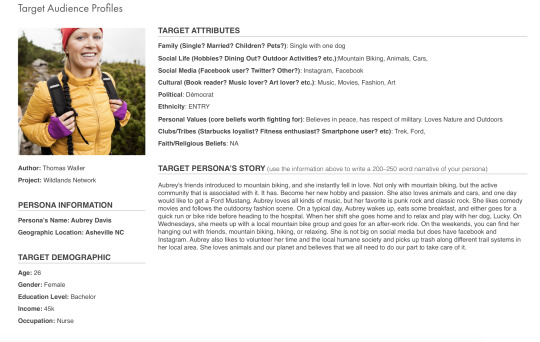
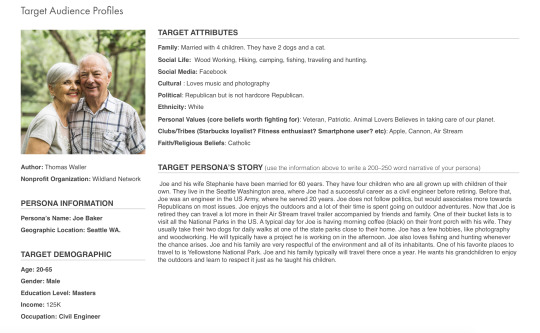
Researching Wildlands Network and what its mission is, I was able to develop the target audience profiles to help create the brand’s voice and messaging. Felton talks about becoming the consumer and how your ad messaging should not address the consumer but should speak to the consumer in a way that represents themselves (p.105).
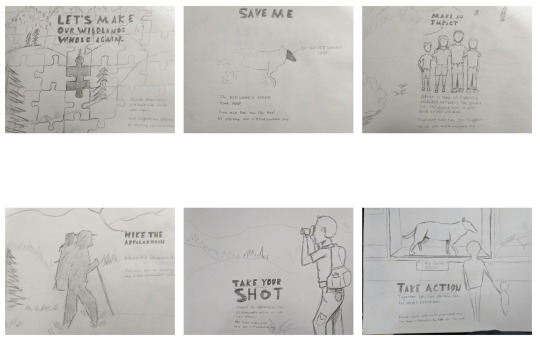
My strategy for the ad sketches was to explore the non-profit and because they have multiple campaigns currently going on, I focused these concept sketches on 3 of those campaigns. Craig Smallish talks about the core values of a product and how those values and beliefs can be related to the consumer (Smallish, 2013). I used the research conducted on the organization and applied their voice and core values into the concept sketches that will relate to the target audience.
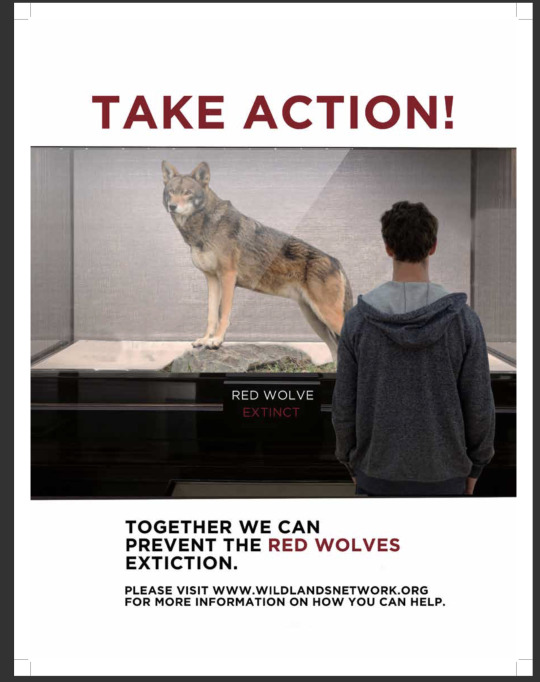
This concept is focusing on the campaign to save the Red Wolve’s from extinction. The message is sort of a warning. If we do not take action now then this animal will no longer be around. Craig Smallish talks about the importance of font selection and how the type can help attract attention (Smallish, 2013). I wanted to bring attention to the headline “Take Action” to help draw the viewer in and raise interest.
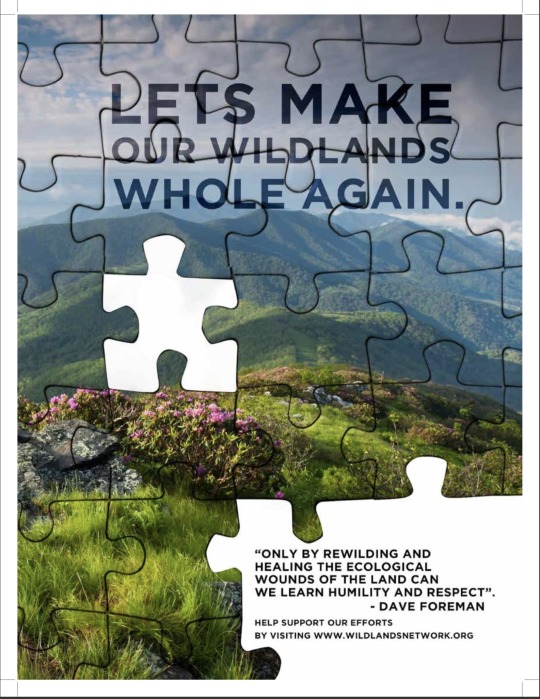
This concept is focused on the Wildlands Network campaign to heal the lands surrounding the Appalachian trails. Since the campaign is about healing and restoring these ecosystems, the concept is to show a puzzle of this beautiful landscape with puzzle pieces missing.
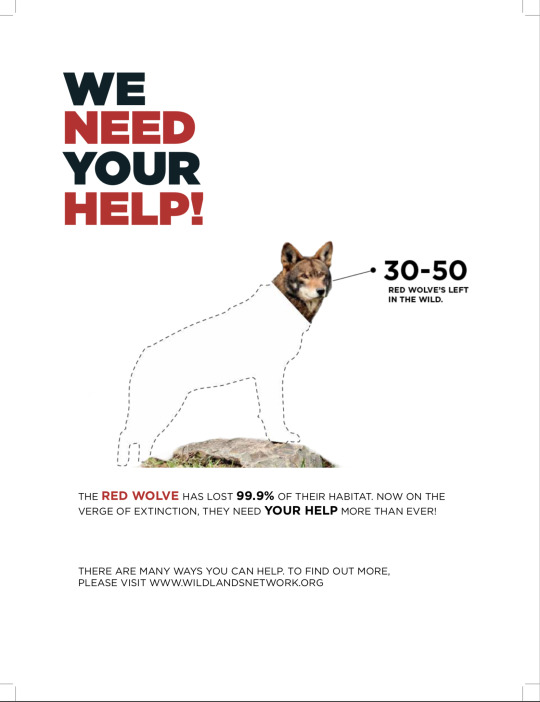
This is another concept for save the Red Wolve’s campaign. Using type and a graphic on a white background to create a dramatic effect. Craig Smallish states that contrast used right, can help direct the viewers eyes along with making elements dominate over others, creating heirarchy (Smallish, 2013).
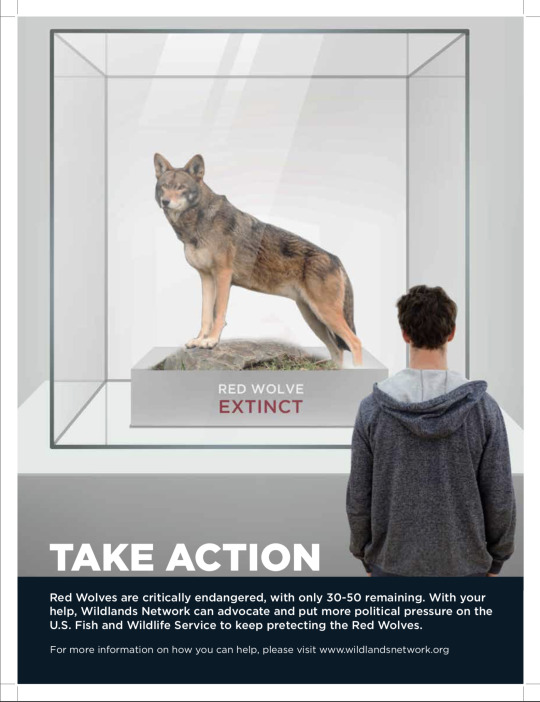
After receiving feedback, I reworked the image to make it go full screen. I also wanted the visual of the Red Wolf in the display to be the hero and then the headline to follow.

For this revision, I made the type more dominant and readable. I removed the missing pieces in the bottom right corner because it was distracting from the other elements. The viewer see the headline then their eyes move to the missing puzzle piece and then down to the body copy.
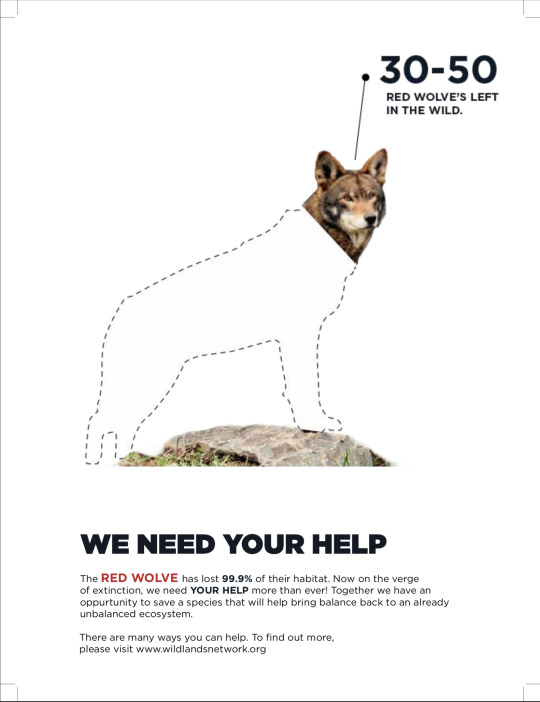
This revision I moved the type to the bottom. I made the graphic larger for a more dramatic effect. The graphic is the hero followed by the type. The contrast helps make the graphic pop.
My takeaways from this course are to really get to know the client and their product. Know the target audience and how why they like the brand and what needs the product fulfills. Knowing the brand's voice and tone can help communicate that message to the target audience.
References
Felton, G. (2013). Advertising: concept and copy(3rd ed.). [PDF Version] Retrieved from https://online.fullsail.edu/class_sections/46769/modules/177929/activities/1113172
Smallish C. (2013) Developing Ideas and Advertising Concepts [Online Course] Retrieved from https://www.lynda.com/Design-Business-tutorials/Using-storytelling-determine-core-values/126121/145393-4.html?srchtrk=index%3a3%0alinktypeid%3a2%
0 notes
Text
An approach - ARTTEACH
All these things contribute to what the late Mark Fisher called ‘the privatisation of stress’.
This sentence, from a London Review of Books article I will have to track down again, triggered a boiling need in me to write a response to something that would be uncovered only in the act of writing about it.
I believe a privatisation of stress is all around us in this current epoch, supporting itself in bottom-linery, which passes on violence the whole way down any line that must refer to it.
It undermines art education (whatever that is, really) through its insidious drip feed to our individual pods.
I MUST support and reinforce the concept of ‘accretion’ - to borrow the word from my good friend Brian Eno’s Oblique Strategies cards. He meant adding more layers of the same thing, more layers of paint perhaps, more voices in a harmony. I have taken it to mean, ‘always adding’, a resistance to the concept of achieving closed goals in education or a career. The painful stressful cul-de-sacs of privatised attainment. Unfortunately they creep into our educational institutions, league tabled, they creep into the consciousness of the people tasked with providing an education at an hourly rate to marry up with a yearly tutorial fee that lays debt upon students who wear that debt as stress for the ‘unknown’ -- the great unknown of ‘making it’ once they graduate. NOT A MINUTE TO WASTE IN MAKING IT. Of course young people feel like that. I felt like that. Along with a large dose of powerlessness, and failing to achieve the bottom rungs of Maslow’s heirarchy of needs.

Who is Mark Fisher? A good friend of one of our tutors, a man we are lucky to have direct reference to through this tutor. An investigative cultural critic of immense dedication. I can only speculate, perhaps one who surveyed the current landscape and felt deep and numb desperation, depression, at the ongoing bereavements we face as sentient beings in a relentless thunder of hateful power-mongery that pulls global strings. (Again I don’t know his story but I find myself wishing he had seen the current swell of ideological naming happening among young people in the seas of privatised stress).
Increasingly, the privatisation of stress needs a counterbalance, that doesn’t feel the need to speak to it in its own language. This is what my teaching is based upon. It has felt an increasingly airless place to speak from, except for in the most important rooms, the actual teaching rooms. My classes are full, they grow from honest conversation.
I implore my fellow colleagues to be wary of zeitgeist. I do understand that we must operate under budgetary constraints, and in political landscapes, and that a great deal of the work of an institution happens beyond the earshot of the students and teacher-students. But we train artists. And what are artists? Artists are people - again to quote my good friend Brian - that spend time on pursuits that do not need to happen. It is such a simple, such a radical assertion. It is entirely obvious - and so easily judged from a utilitarian standpoint - but if we need parallels, perhaps a useful one is the right to roam in the UK, something that took hard work and dedication to achieve. I think it is a useful metaphor. Artists spend time on neural journeys that do not need to happen, they roam.
This definition is debatable on some fronts, but it is very useful. Implicitly, if art is made by people doing things that do not need to happen, it is made by people voluntarily (however compelled by traditional notions of angst they may be). It is made by people resisting the ‘privatisation of stress’. They may look at the same building blocks of society and see them very differently. Ozymandian heads in the sand may replace the groping sky feelers of glass offices, skylines may become musical scores, roads the surfaces for virtual reality games of frogger or blends of colour.
People in education balk at saying that we are training ‘artists’ at all, as if the very low odds of students making a financially stable career from their craft equates to those students failing to make the grade. The odds are incredibly low. As Norman Potter says to raise expectations is rash, a steadier light must be fostered. But to suggest that ‘poorly read’ young people cannot be ‘artists’ because they cannot articulate the foundations they stand upon is also rash. They will not climb into the next ring of experience if they only make poems about their inner turmoil in descriptive terms, but poems about inner turmoil are a perfectly reasonable training ground, they are a good base layer of paints in an ongoing accretion of tones.
A collection of these poems - or one particular mode of performance of them -may command attention from a group of young people at a similar stage of emotional growth. It may command enough attention to encourage their author to print a book of them, sing them with a bass player, or adapt and tour them in community centres.
The only dangers here are a. discounting this early rung of a ladder as not consciously deeply rooted enough in cultural history, as too shallow for serious attention or b. praising the ‘success’ of the venture and creating a closed circuit in a young mind that attempts to replicate the success rather than applying the next layer of paint.
Encouraging a young person to contextualise their work (once some has actually been done) is a very laudable element of education. We must all find out that our ideas do not exist in the perfect vacuum of our own original thought. We all feel some passing sadness at this, or amusement at our folly. Many of us carry on regardless, from this new context. So what? We are still artists. We are still drawn to make things that do not need to exist.
As I seem to say in most of my meetings about curriculum design and educational model, I want the teacher’s impact to seem incredibly sparse and minimal. I want the task to do the teaching. I want the artists in the room to make the things that don’t need making and then work out what they’ve done, or fail to work it out but find another point to jump off from, or an experience to mark down for future return, or just to flap in the breeze and note down something/anything of interest that flies past.
Making from triggers. Making new triggers. Treating the creative mind as a cybernetic network not a road system.
The task may also be to study the thoughts of others, and to be able to critically analyse those thoughts. This takes some serious dedication. But this can happen alongside making from the energy most authentic in each artist, WE ARE ALL ARTISTS (reminding me of the documentary film that predicted the rise of individual pod based online persona, exciting ---> destructive, what was its name?) and to deny this fact is to buy into the very notions of marketisation and stress economy that I believe we should be resisting (by suggesting that only a very select few may actually grow to dare to call themselves artists).
Why am I writing this then? I’m still not clear myself. I have asked my students to make a portfolio of their work, to show off their learning this year so far. This initially causes stress as a task. Although it is open and supported by notes encouraging honest reflection, the positioning of it in ‘a course’ means it feels judged, it implies a level of sophistication and prowess. It makes students cower a little at the things we made that didn’t need to be made.
It makes us ashamed of amateurism.
That, I resist very strongly. Get the essence of the thing down, store it somewhere you can look at it. Let it emit. How does it emit? How else could it emit? Try that? Scrap it, try again. Or save it, try again. Share it with someone else. Mark down some things it makes you think. Let someone else tell you what it makes them think. Ask a total stranger to perform or record it for you as a clearly boundaried experiment.
A portfolio is just pages to show. Who said it was the greatest work you have? It is the greatest work of your own connecting neurons, and you may look at it again once it is recorded and reflect on it.
Make it live (as alive as your ever growing practice).
0 notes